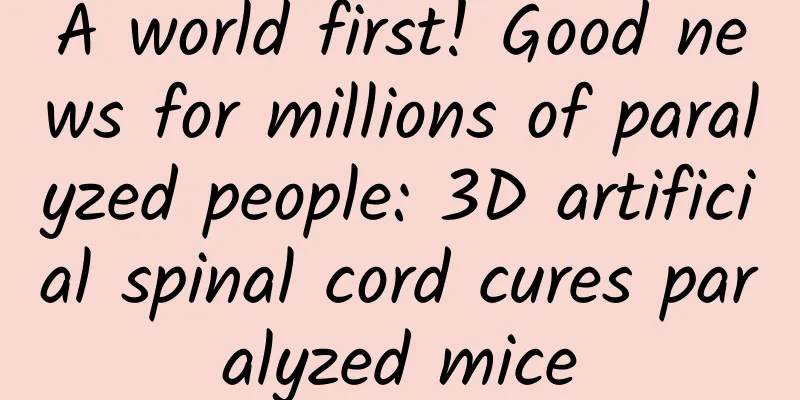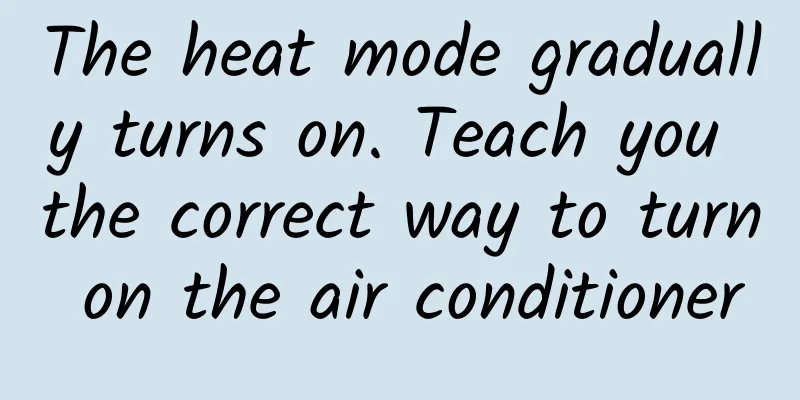A world first! Good news for millions of paralyzed people: 3D artificial spinal cord cures paralyzed mice

|
Written by: Zhu Hengheng Editor: Wang Haha Layout: Li Xuewei In daily life, traumatic paraplegia caused by accidental falls or traffic accidents affects the lives of millions of people around the world. Generally speaking, there is currently no very effective treatment for patients with complete spinal cord transection, damaged nerve cells, and broken nerve fibers. Most of them are paralyzed for life and have a very poor quality of life. And now, there is finally hope. Recently, a research team led by Dr. Tal Dvir from the Sagol Center for Regenerative Biotechnology at Tel Aviv University in Israel, in collaboration with Israeli regenerative medicine company Matricelf, successfully developed a 3D printed spinal cord tissue implant that can effectively repair broken spines. In animal tests, the new therapy restored the ability to walk in 100% of early paralyzed mice and 80% of long-term paralyzed mice. Professor Dvir said, "In a paralyzed mouse model, the new 3D printed spinal cord tissue implant can quickly repair the damaged spine of the mice and eventually restore their ability to walk. This is reportedly the world's first example of a tissue engineering implant restoring movement in a long-term paralyzed animal model, which is also the most relevant model for the treatment of human paralysis." The related research, titled “Regenerating the Injured Spinal Cord at the Chronic Phase by Engineered iPSCs-Derived 3D Neuronal Networks”, was published in the latest issue of Advance Science magazine. Irreversible traumatic spinal cord injury Speaking of traumatic spinal cord injury, I believe everyone is familiar with it. Traumatic spinal cord injury refers to a disease in which our spine is damaged due to external impact, resulting in paralysis of the limbs below the injury site. Under the action of external forces, the spine will be directly damaged, resulting in the death of nerve cells, destruction of the blood-spinal barrier and degradation of the extracellular matrix. After that, a secondary pro-inflammatory injury cascade will occur in the damaged area, further destroying the damaged tissue, forming glial scars, and leading to permanent neurological dysfunction. Generally speaking, the prognosis of patients varies greatly depending on the degree of spinal cord damage. For mild injuries, such as spinal cord contusion, there is no obvious organic change, only a short-term spinal shock, and the prognosis of such patients is good and will hardly affect their normal life. For patients with severe injuries, such as epidural hematoma, although most functions can be restored, there will still be sequelae. The most serious are patients with complete spinal cord rupture and severe nerve cell damage. Such patients are almost impossible to recover motor or sensory functions, and most face lifelong paralysis. (Source: Pixabay) Currently, in order to reconnect the injured spinal cord, clinical researchers have proposed a variety of methods, such as transplanting different types of cells or biomaterials into the damaged site during the acute injury period. A variety of cell transplantation therapies including Schwann cells, neural stem cells, neural progenitor cells or mesenchymal stem cells have been tested. However, during the experiment, people found that there are two main problems in the cell transplantation process that can lead to transplantation failure: one is the immune rejection reaction caused by different types of cells, such as allogeneic cells or xenogeneic cells, and the other is the failure of the implanted cells to successfully spontaneously organize into a functional network. To solve the problem of immune rejection, autologous induced pluripotent stem cells are a feasible solution. Somatic cells obtained from patient tissues are reprogrammed into pluripotent stem cells and then differentiated into the desired cell line. Studies have shown that 2 weeks after inducing spinal cord injury in animal models, neural stem cells derived from isolated induced pluripotent stem cells are inserted into a fibrin matrix. These cells are able to differentiate and interact with host neurons to form axons and repair damaged spinal nerves. Although this method has certain effects, during use, due to cell-cell interaction or cell-matrix interaction, the transplanted cells will inevitably integrate with normal tissues. And because the scar tissue generated during the pathological process cannot support the microenvironment of nerve repair, a large number of cells may die. Therefore, inserting preformed 3D neural networks into the injury site without affecting scar tissue may improve the therapeutic effect. However, previous exploration of engineered functional 3D neural network transplantation models is very limited. 3D-printed implant cures paralyzed mice Dr. Tal Dvir has long been committed to the research of 3D bioprinting technology. He is also one of the founders of the regenerative medicine company Matricelf. In this study, the research team led by Dr. Dvir pioneered the use of 3D bioprinting technology to simultaneously print the patient's cells and extracellular matrix to produce living human tissues and organs. First, researchers will take a biopsy of the patient's abdominal fat tissue. This tissue, like other tissues in the human body, is composed of cells and extracellular matrix. After separating the cells and extracellular matrix, researchers will use genetic engineering to reprogram the cells to restore them to the state of embryonic stem cells. The researchers then used the extracted extracellular matrix to produce a personalized hydrogel that would not trigger an immune rejection response after implantation. Encapsulating the cultured stem cells in the hydrogel simulated the embryonic development of the spinal cord and subsequently became a 3D neural network implant containing motor neurons. Figure | Treatment diagram (Source: Advance Science) Finally, the researchers tested the functionality of the new implant in two animal models, an acute SCI model and a long-term SCI model (equivalent to 1 year after human injury). The results showed that this new type of 3D neural network implant could quickly repair the damaged spine of paralyzed mice after implantation. Ultimately, all the acutely paralyzed mice that received the transplant regained the ability to walk, and 80% of the mice in the long-term paralysis mouse model also regained the ability to walk. In this regard, Dr. Dvir said, "Millions of people around the world are paralyzed by spinal cord injuries, and there is still no effective treatment for their condition. Many young people are destined to spend the rest of their lives in a wheelchair, which costs a lot of money. Our goal is to produce a personalized spinal cord implant for every paralyzed person, so that the damaged tissue can regenerate without rejection." Overall, Dr. Dvir's pioneering 3D printed spinal cord tissue graft successfully cured mice paralyzed by spinal cord injury, allowing them to walk again. This is undoubtedly a remarkable scientific achievement, representing a huge advance in spinal cord regenerative medicine, and may bring hope of cure to many spinal cord injury patients in the future. It is reported that Matricelf is now actively communicating with the US FDA and is preparing to enter human trials with its 3D printed spinal cord implants by the end of 2024. The company said that humans may only be a few years away from curing paralysis. References: https://onlinelibrary.wiley.com/doi/10.1002/advs.202105694 https://neurosciencenews.com/spinal-cord-implant-paralysis-20030/ Source: Academic Headlines |
Recommend
How to increase popularity in Kuaishou live broadcast room? After reading this, you can solve your popularity problem with just one click!
Professional Douyin and Kuaishou likes-boosting p...
22 satellites in one rocket! Long March 8 opens a new model of shared rocket "carpooling"
On the 27th, the "shared rocket" - the ...
Detailed example explanation: 10 screenshot design techniques to quickly increase download conversion rate!
Apple_HD_Wallpapers_www.laba.ws In the "popu...
There is a threshold for entry into 1688 Chengxintong’s virtual information difference products, but the returns are considerable!
Everyone knows that the 1688 platform is a wholes...
How did Panda Mini Class gain nearly one million fans through fission?
Knowledge payment has been very popular in recent...
The tragedy of LeTV's suspension: Financing customers face a black hole of losses
LeTV's "indefinite" suspension of t...
How do girls react? What are girls' physiological reactions like?
How do girls react? When lovers and couples kiss,...
Thanks to China, Apple finally allows the "reward" function
[[203969]] Sina Technology News, Beijing time, Se...
Meituan takeaway channel operation skills!
When the mini program was not yet launched, and w...
3 steps to improve the conversion of information flow, learn them!
Why is my ad not getting any exposure no matter h...
Shocking! Eating too much high-protein food can cause such serious harm! After reading this, do you still dare to eat like this?
Compiled by: Gong Zixin High-protein diet is a po...
iOS 15 will focus on optimizing the notification center and lock screen interface
Bloomberg reported that iOS 15, which will be rel...
Why mosquitoes aren't going away? Here's some good news and some bad news
"Buzz, buzz, buzz..." One of the nightm...
11 ways to attract private domain traffic on Douyin
Although Douyin is relatively more focused on pub...
Android 7.0 vs. iOS 10: Which is better?
The competition in the mobile operating system spa...









